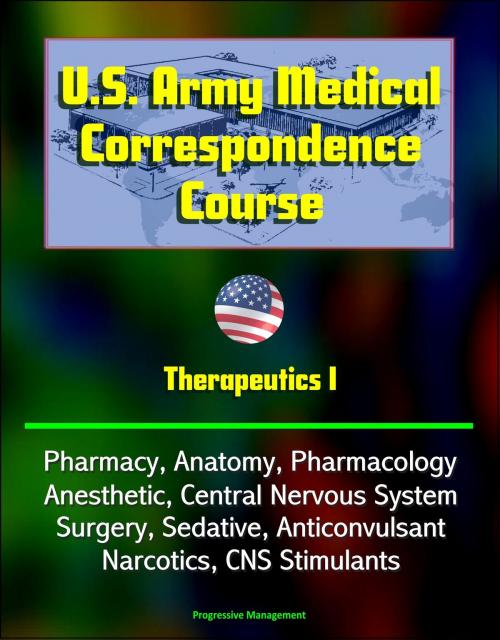U.S. Army Medical Correspondence Course: Therapeutics I - Pharmacy, Anatomy, Pharmacology, Anesthetic, Central Nervous System, Surgery, Sedative, Anticonvulsant, Narcotics, CNS Stimulants
Nonfiction, Health & Well Being, Medical, Specialties, Pharmacy, Medical Science, Pharmacology| Author: | Progressive Management | ISBN: | 9781310952906 |
| Publisher: | Progressive Management | Publication: | October 20, 2014 |
| Imprint: | Smashwords Edition | Language: | English |
| Author: | Progressive Management |
| ISBN: | 9781310952906 |
| Publisher: | Progressive Management |
| Publication: | October 20, 2014 |
| Imprint: | Smashwords Edition |
| Language: | English |
A patient who visits a physician or physician extender frequently receives a prescription for a medication. That prescription is brought to the pharmacy to be filled. The patient expects professional attention at the pharmacy. Part of that expectation involves any caution or warning the patient should heed while taking the medication.
In your role, you will serve as a source of drug information. Patients and friends will ask you specific questions concerning the use of prescription and over-the-counter medications. You must know the trade and generic names of literally hundreds of medications. Furthermore, you must know the cautions and warnings associated with many agents.
How are you to know this information about drugs? Certainly you have had instruction which presented the basics of anatomy, physiology, and pharmacology. This instruction has given you a sound foundation for learning more in these areas. This subcourse will present instruction in anatomy, physiology, and pharmacology. The material in anatomy and physiology is included to refresh your memory or to give you additional information so you can better understand the pharmacology material.
This subcourse is approved for resident and correspondence course instruction. It reflects the current thought of the Academy of Health Sciences and conforms to printed Department of the Army doctrine as closely as currently possible.
INTRODUCTION * CHAPTER 1 - PROFESSIONAL REFERENCES IN PHARMACY * Section I. General * Section II. Pharmaceutical Journals * Section III. Pharmaceutical Texts * Section IV. Electronic Drug Information Services * Exercises * CHAPTER 2 - ANATOMY, PHYSIOLOGY, AND PATHOLOGY IMPORTANT TO THERAPEUTICS * Section I. Principles of Anatomy and Physiology * Section II. Cells * Section III. Tissue * Section IV. Skin * Section V. Nature and Causes of Disease * Section VI. Treatment of Disease and Injury * Exercises * CHAPTER 3 - INTRODUCTION TO PHARMACOLOGY * Section I. Terms and Definitions Important in Pharmacology * Section II. Introduction to Drugs * Section III. Considerations of Drug Therapy * Section IV. Factors Which Influence Drug Action * Exercises * CHAPTER 4 - LOCAL ANESTHETIC AGENTS * Section I. Background Information * Section II. Local Anesthetics and Their Clinical Uses * Exercises * CHAPTER 5 - THE CENTRAL NERVOUS SYSTEM * Section I. Basic Concepts of the Nervous System * Section II. The Neuron and its "Connections" * Section III. The Human Central Nervous System * Exercises * CHAPTER 6 - AGENTS USED DURING SURGERY * Section I. General Anesthetic Agents * Section II. Other Agents Used During Surgery * Exercises * CHAPTER 7 - SEDATIVE AND HYPNOTIC AGENTS * Section I. Background * Section II. Clinically Important Information Concerning Sedative-Hypnotics * Section III. Classification of Sedative-Hypnotic Agents * Exercises * CHAPTER 8 - ANTICONVULSANT AGENTS * Section I. Review of Epilepsy * Section II. Anticonvulsant Therapy * Exercises * CHAPTER 9 - PSYCHOTHERAPEUTIC AGENTS * Section I. Overview * Section II. Antianxiety Agents * Section III. Antidepressant Agents * Section IV. Antipsychotic Agents * Exercises * CHAPTER 10 - CENTRAL NERVOUS SYSTEM (CNS) STIMULANTS * Section I. Background * Section II. Cerebral or Psychomotor Agents * Section III. Analeptic Agents (Brain Stem Stimulants) * Section IV. Convulsants (Spinal Cord Stimulants) * Exercises * CHAPTER 11 - NARCOTIC AGENTS * Section I. Background * Section II. Narcotic Agents and Narcotic Antagonists * Exercises * ANNEX: DRUG PRONUNCIATION GUIDE
A patient who visits a physician or physician extender frequently receives a prescription for a medication. That prescription is brought to the pharmacy to be filled. The patient expects professional attention at the pharmacy. Part of that expectation involves any caution or warning the patient should heed while taking the medication.
In your role, you will serve as a source of drug information. Patients and friends will ask you specific questions concerning the use of prescription and over-the-counter medications. You must know the trade and generic names of literally hundreds of medications. Furthermore, you must know the cautions and warnings associated with many agents.
How are you to know this information about drugs? Certainly you have had instruction which presented the basics of anatomy, physiology, and pharmacology. This instruction has given you a sound foundation for learning more in these areas. This subcourse will present instruction in anatomy, physiology, and pharmacology. The material in anatomy and physiology is included to refresh your memory or to give you additional information so you can better understand the pharmacology material.
This subcourse is approved for resident and correspondence course instruction. It reflects the current thought of the Academy of Health Sciences and conforms to printed Department of the Army doctrine as closely as currently possible.
INTRODUCTION * CHAPTER 1 - PROFESSIONAL REFERENCES IN PHARMACY * Section I. General * Section II. Pharmaceutical Journals * Section III. Pharmaceutical Texts * Section IV. Electronic Drug Information Services * Exercises * CHAPTER 2 - ANATOMY, PHYSIOLOGY, AND PATHOLOGY IMPORTANT TO THERAPEUTICS * Section I. Principles of Anatomy and Physiology * Section II. Cells * Section III. Tissue * Section IV. Skin * Section V. Nature and Causes of Disease * Section VI. Treatment of Disease and Injury * Exercises * CHAPTER 3 - INTRODUCTION TO PHARMACOLOGY * Section I. Terms and Definitions Important in Pharmacology * Section II. Introduction to Drugs * Section III. Considerations of Drug Therapy * Section IV. Factors Which Influence Drug Action * Exercises * CHAPTER 4 - LOCAL ANESTHETIC AGENTS * Section I. Background Information * Section II. Local Anesthetics and Their Clinical Uses * Exercises * CHAPTER 5 - THE CENTRAL NERVOUS SYSTEM * Section I. Basic Concepts of the Nervous System * Section II. The Neuron and its "Connections" * Section III. The Human Central Nervous System * Exercises * CHAPTER 6 - AGENTS USED DURING SURGERY * Section I. General Anesthetic Agents * Section II. Other Agents Used During Surgery * Exercises * CHAPTER 7 - SEDATIVE AND HYPNOTIC AGENTS * Section I. Background * Section II. Clinically Important Information Concerning Sedative-Hypnotics * Section III. Classification of Sedative-Hypnotic Agents * Exercises * CHAPTER 8 - ANTICONVULSANT AGENTS * Section I. Review of Epilepsy * Section II. Anticonvulsant Therapy * Exercises * CHAPTER 9 - PSYCHOTHERAPEUTIC AGENTS * Section I. Overview * Section II. Antianxiety Agents * Section III. Antidepressant Agents * Section IV. Antipsychotic Agents * Exercises * CHAPTER 10 - CENTRAL NERVOUS SYSTEM (CNS) STIMULANTS * Section I. Background * Section II. Cerebral or Psychomotor Agents * Section III. Analeptic Agents (Brain Stem Stimulants) * Section IV. Convulsants (Spinal Cord Stimulants) * Exercises * CHAPTER 11 - NARCOTIC AGENTS * Section I. Background * Section II. Narcotic Agents and Narcotic Antagonists * Exercises * ANNEX: DRUG PRONUNCIATION GUIDE















